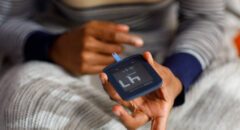 There’s something about the term “prediabetes” – maybe it’s the “pre” – that makes it sound less worrisome than it really is. Prediabetes is a condition that occurs when blood sugar levels are elevated but not high enough yet to indicate type 2 diabetes. Prediabetes is a major public health concern, one that everyone should learn more about.
There’s something about the term “prediabetes” – maybe it’s the “pre” – that makes it sound less worrisome than it really is. Prediabetes is a condition that occurs when blood sugar levels are elevated but not high enough yet to indicate type 2 diabetes. Prediabetes is a major public health concern, one that everyone should learn more about.
If left untreated, prediabetes often leads to type 2 diabetes, a leading cause of blindness, heart disease, and kidney failure. According to the U.S. Centers for Disease Control and Prevention (CDC), 1 in 3 adults in the U.S. has prediabetes and of these individuals, 90 percent of them don’t even know it. That’s because prediabetes can be a “silent” condition, causing few noticeable symptoms. Because people with prediabetes don’t typically feel sick, many don’t know to seek medical attention.
Fortunately, you can find out your risk for prediabetes in less than a minute: DoIHavePrediabetes.org, created by the Ad Council, AMA, and CDC, offers a quick test to help you find out where you stand.
If you receive a high score on the risk test, you should talk to your doctor about getting your blood sugar tested. There are two common tests:
- Fasting blood glucose (FGB): Which measures your blood sugar after not eating for 8 hours.
- Hemoglobin A1C (HbA1c): Which measures your average blood sugar over the past 2-3 months.
Type 2 diabetes requires lifelong management, often including medication. But prediabetes, if diagnosed before it progresses to type 2 diabetes, can be treated and may even be reversed. Small, actionable changes to your lifestyle can go a long way toward lowering blood sugar and keeping prediabetes in check. Here are a few things you can start doing today to reverse prediabetes and prevent type 2 diabetes:
- Lose weight: Research shows that you can cut your risk for type 2 diabetes in half by losing 5-7 percent of your body weight. If you are 200 pounds, that is 10-15 pounds.
- Move more: Exercising moderately (walking briskly, for example) for 30 minutes a day, five days a week can help reduce blood sugar levels.
- Eat well: Eat more healthy foods, such as vegetables, fruits, and lean proteins (fish, chicken, turkey, tofu, eggs, yogurt, to name a few). Eat fewer foods that are high in calories, fat, and sugar, and avoid trans fat and eat less saturated fat.
Prediabetes is a serious condition, and diagnosis is key. Want to know more about your prediabetes risk? Take the prediabetes risk test now to know where you stand!







